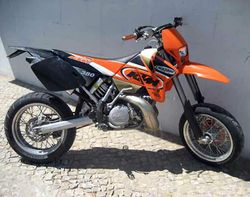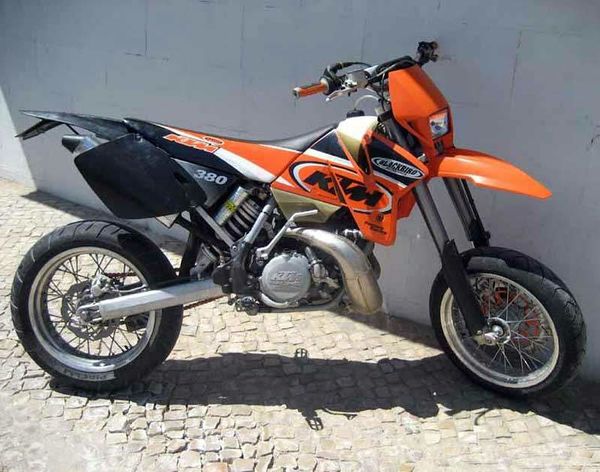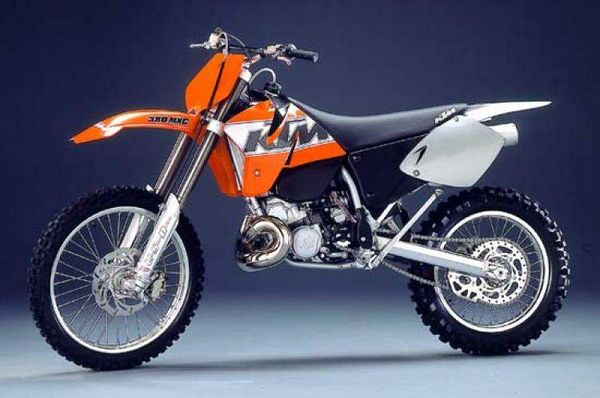KTM 380 EXC
 |
|
| KTM EXC380 | |
| Manufacturer | |
|---|---|
| Also called | 380 EXC |
| Production | 2000 - 01 |
| Engine | Two stroke, single cylinder, twin valve control exhaust system |
| Ignition | KOKUSAN 2K-2 |
| Spark Plug | NGK BR 8 ECM, electrode gap 0,6 mm (0,024 in) |
| Transmission | 5 Speed |
| Final Drive | Chain: 520x118 ‘98-02[1] |
| Front Sprocket | 14T ‘98-02[1] |
| Rear Sprocket | 52T ‘98-02[1] |
| Frame | Central chrome-moly-steel frame |
| Suspension | Front: 50 mm WP Extreme upside down forks and shock Rear: WP Progressive Damping System shock absorber, aluminum swingarm |
| Brakes | Front: Single 260 mm disc, floating caliper Rear: Single 220 mm disc, floating caliper |
| Front Tire | 90/90 - 21 54R |
| Rear Tire | 140/80 -18 70R |
| Wheelbase | 1481 mm / 58.3 in |
| Weight | 109 kg / 240 lbs (dry), |
| Fuel Capacity | 9.5 L or 12 L / 2.5 US gal or 3.2 US gal / 2.1 Imp gal or 2.6 Imp gal |
| Manuals | Service Manual |
Engine[edit | edit source]
The engine was a Liquid cooled cooled Two stroke, single cylinder, twin valve control exhaust system.
Chassis[edit | edit source]
It came with a 90/90 - 21 54R front tire and a 140/80 -18 70R rear tire. Stopping was achieved via Single 260 mm disc, floating caliper in the front and a Single 220 mm disc, floating caliper in the rear. The front suspension was a 50 mm WP Extreme upside down forks and shock while the rear was equipped with a WP Progressive Damping System shock absorber, aluminum swingarm. The 380 EXC was fitted with a 9.5 L or 12 L / 2.5 US gal or 3.2 US gal / 2.1 Imp gal or 2.6 Imp gal fuel tank. The bike weighed just 109 kg / 240 lbs. The wheelbase was 1481 mm / 58.3 in long.
Photos[edit | edit source]
Overview[edit | edit source]
KTM 380 EXC
Of all the 2 stroke options why the 380 you
might ask? Well the 380 was offered from 1998-2002 and shares the
same chassis as the 250/300 which means it is much more modern than
the larger 440/550 chassis. The 380 also incorporates a power-valve
which is one of the reasons it can deliver decent low end power and
still rev out fairly well. At the same time it isnt overly
aggressive in its power delivery like a 250 mx bike might be. The
380 delivers its meaty power much slower than an mx style bike. In
addition it is still somewhat easy to get parts for the 380, at
least for the time being. Finding parts for the true 440/550 big
bores is becoming a chore and when you do find them you will pay top
dollar.
My target years for a 380 were in the 2000-2002 time-frame because during those years the bikes came with the newer and lighter upside forks as well as the higher-output ignition that would support the future addition of lighting quite well. After scanning the internet for a few months I came across a fairly clean 2000 380MXC. The MXC means it has a close ratio transmission which allows the bike to pull from gear to gear and stay right in the meat of the power. The fact that I intend to use this bike for the open desert with sand washes and hill climbs as well as at the dunes makes the MXC tranny a good choice. From the ad it appeared the bike was mostly stock with the exception of a Pro-Circuit Platinum pipe and a FMF Q spark arrestor. Even the chain and sprockets looked to be stock, overall a good sign.
I fired up the 380 and headed out onto Backbone trail. Backbone trail winds it way up and down along a ridgeline for a few miles before dropping back into the valley. Right away the 380 was lofting its front wheel coming out of the turns and heading down the straights. A little more throttle control was definitely a necessity over riding the 525 on the same trail. The 525 is no slouch but on the 380 things just happen quicker. While the carburetion felt a little rich from ¼ throttle and into the midrange the bike had no trouble revving out when the trail opened up a bit. Upon decelerating into the corners I noticed the bike was surging a bit, a possible sign of a lean pilot and/or misadjusted air screw.
Knowing a little about my friends old 380s finicky jetting needs should help me get this bike ironed out in the jetting department. The 380s are known for being somewhat hard to jet in stock form. If you try and richen up the pilot to get rid of the surging then you can run into fouling plugs because the ¼- midrange is already on the blubbery side and you begin compounding the problem. The formula for success on one of my buddies 380 was to get the cylinder head reshaped for cleaner burning which resulted in bike that responded much better to jetting changes. Reshaping the head requires a professional machinist or at least someone with the tools and know how to do the job, neither of which I was able to find just standing around at Gorman that day.
Once off of Backbone trail and onto the valley floor I was able to get into a sand wash and really open up the 380. It really pulls with authority from the midrange through the top-end. The 300 my buddy was riding felt more like a 200 compared to the 380. The 380 has much more low end and midrange power over the 300. Gearing wise the 380 wont reach the same top-speed as my 525 because it is a 5 speed over the 525s 6 speed wide-ration transmission. In the sand washes the 380 seems to just jump right to the top of the sand and float along instead of sinking in like my 525 tends to do.
Overall I was very happy with the power despite the obvious need for jetting changes but what about the handling? The suspension on the bike was apparently setup by Dicks Racing for around a 220 pound rider, well over my 180 pound riding weight. The spring rates on both the fork and shock are too stiff for me which prevented the bike from wanting to settle into the corners. Despite this fact the valving on both ends felt very controlled and balanced, responding equally well to whoops and trail chop. One of the future changes with the suspension will at a minimum need to be a change to lighter springs.
So far the 380 has not disappointed and getting back on a semi-big bore two-stroke has brought back some great memories. The power delivery and excitement of the 380 two-stroke cant be matched by any four-stroke that I have ridden to date. I am already looking forward to getting some desert seat time in on the bike to see what it can do. Before that happens however I want to make sure the bike is reliable. Stay tuned as I continue with articles covering my progress of going through the bike, checking and rebuilding anything that looks suspect and then getting it dialed in. Review: Eric Tabb,
| Make Model | KTM 380 EXC |
|---|---|
| Year | 2000 - 01 |
| Engine Type | Two stroke, single cylinder, twin valve control exhaust system |
| Displacement | 368 cc / 22.5 cu in |
| Bore X Stroke | 78 x 77 mm |
| Cooling System | Liquid cooled |
| Induction | Keihin PWK 38 AG flat slide carburetor |
| Fuel | 1:40 - 1.60 when using high grade two stroke oil |
| Ignition | KOKUSAN 2K-2 |
| Starting | Kick |
| Spark Plug | NGK BR 8 ECM, electrode gap 0,6 mm (0,024 in) |
| Transmission | 5 Speed |
| Final Drive | Chain |
| Primary Drive Ratio | 26:72 |
| Gear Ratios | 1st 15:29 1 / 2nd 18:26 / 3rd 19:22 / 4th 21:20 / 5th 23:18 |
| Final Drive Ratio | 14:52 |
| Frame | Central chrome-moly-steel frame |
| Front Suspension | 50 mm WP Extreme upside down forks and shock |
| Front Wheel Travel | 280mm / 11.0 in |
| Rear Suspension | WP Progressive Damping System shock absorber, aluminum swingarm |
| Rear Wheel Travel | 320 mm / 13.6 in |
| Front Brakes | Single 260 mm disc, floating caliper |
| Rear Brakes | Single 220 mm disc, floating caliper |
| Front Tire | 90/90 - 21 54R |
| Rear Tire | 140/80 -18 70R |
| Wheelbase | 1481 mm / 58.3 in |
| Dry Weight | 109 kg / 240 lbs |
| Fuel Capacity | 9.5 L or 12 L / 2.5 US gal or 3.2 US gal / 2.1 Imp gal or 2.6 Imp gal |
External Links[edit | edit source]
References[edit | edit source]
- ↑ 1.0 1.1 1.2 2019 Western Power Sports Catalog. Western Power Sports. 2019.

